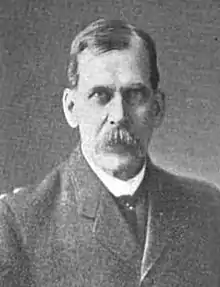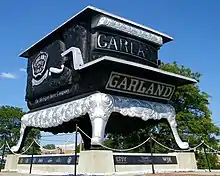William J. Keep
William J. Keep (also William John Keep) (June 3, 1842 – September 30, 1918) was an American mechanical engineer who worked with molten metals in foundries. He mixed aluminum and other elements with iron to come up with new alloys with different characteristics that were used for stoves and heaters. He was known as a consulting engineer to the Michigan Stove Company that was founded by Jeremiah Dwyer.
William J Keep | |
|---|---|
 Circa 1914 | |
| Born | June 3, 1842 Oberlin, Ohio, US |
| Died | September 30, 1918 (aged 76) |
| Nationality | American |
| Other names | William John Keep |
| Occupation | designer and engineer of stoves |
| Title | Mechanical Engineer |
| Spouse(s) | Sara Frances Henderson |
| Children | 2 |
Early life
Keep was born in Oberlin, Ohio on June 3, 1842. He was son of Theodore John Keep and his wife Mary Ann Thompson.[1] Keep was a genealogist and he traced his paternal line from his earliest American ancestor who came from England, John Keep. John settled at Longmeadow, Massachusetts in 1660.[2] His wife was Sarah Leonard. John and Sarah had a son, Ensign Samuel. His wife was Sarah Colton and they had one child, Samuel. Samuel's wife was Sabrina Cooley and they had one child, John. He and his wife Lydia Hale, were the grandparents of William John Keep.[3]
Keep went to the Oberlin public schools when he grew up.[4] After graduating from high school he first attended Oberlin College for the freshman and sophomore years.[5] He later attended Union College in Schenectady, New York. There he graduated with a degree in civil engineering in 1865.[6] Keep's natural ability was as a mechanic and before entering Union College to learn mechanical engineering he became a machinist at Globe Iron Works in Cleveland.[1]
American Civil War
Keep was a first corporal in the Oberlin company of the Squirrel Hunters under martial law of Union General Lew Wallace. He was in charge of forces to repel an invasion into southern Ohio led by Confederate General Edmund Kirby Smith in September 1862.[3]
Mid life
Keep in 1865 became a foreman at Hubbell & Brothers Stove Works in Buffalo, New York and was there from 1865 to 1868.[7] In 1868 he became superintendent of the stove manufacturing plant of Fuller Warren & Co in Troy, New York.[6] Keep was there for nearly eight years.[7] Keep gave lectures on the steam engine to the senior class at Rensselaer Polytechnic Institute during the time he lived at Troy from 1872 to 1877.[4][6][7] In 1875 he started manufacturing stoves himself and did that until 1884.[1][3][7]
Keep in 1884 moved to Detroit, Michigan. There he became the general superintendent of Michigan Stove Company.[1] He was in this capacity until 1910 when he was promoted to consulting engineer for the company.[5] He continued in this capacity until his death. During the time he worked for the company he caused a major improvement in the way they constructed stoves. Keep in 1872 patented the base burning stove. It had two rows of mica windows, one above the top of the fire-pot and one below. He patented in 1887 the baseburner with a reflector above the fire. That became standard for the stove industry.[3]

Keep innovated a new process of making malleable iron castings using a secret mix of iron ore, aluminum and other elements. Michigan Stove Company used his patented mixes to make their stoves. Keep received many patents during his thirty-five years with the company. He was deeply interested in metallurgical research and wrote articles for the American Institute of Mining Engineers for nearly a decade starting in 1888. He also wrote articles for the ASME starting in 1894 and did that for the rest of his life.[3]
Keep in 1885 figured out the relationship between shrinkage and chemical composition of cast iron in a testing process.[5] He did this through an assessment that was referred to as "Keep's Test."[7] This later was named "Mechanical Analysis" and became the worldwide industrial measure instead of chemical analysis.[4] Keep devised this analysis as a result of thousands of tests, which he described in detail in his 1893 pamphlet he wrote titled Keep's test for cast iron.[1][8][9] The pamphlet chronicled his tests and outlined the influence of aluminum, silicon, phosphorus, sulfur, and manganese on cast iron. This was also reported in his paper "Keep's Cooling Curves" that showed shrinkage and strength impact to cast iron mixes of various formulas of these elements.[3] Keep devised and invented many testing machines and methods that were used in the foundry industry.[1][10]
World's Largest Stove
As the Michigan Stove Company factory superintendent, Keep designed the World's Largest Stove for the 1893 Chicago's World Fair.[11] The vice president of the company George Harrison Barbour came up with the idea of making a giant stove and had woodcarvers construct and carve the mammoth 15 ton replica according to Keep's designs.[12][13]
Memberships and affiliations
Keep was a Republican. He belonged to the following.
- American Association for the Advancement of Science
- International Association for Testing and Materials
- American Institute of Mining Engineers
- Iron and Steel Institute of Great Britain
- New England Society of New York
- Rensselaer Society of Engineers
- ASME for Mechanical Engineers
- Sons of the American Revolution
- Franklin Institute of Philadelphia
- Engineering Society of Detroit
- American Foundry Society[10]
Personal
Keep was married to Sarah Frances Henderson in Oberlin on May 22, 1866.[1][3] They had two children that lived to adulthood. Helen Elizabeth (b. 12/10/1868) who was a Michigan state chairwoman and member National League for Women's Service. Henry (b.7/19/1873) who worked in the engineering field. During World War I he was a lieutenant colonel in charge of construction in France serving as assistant to the chief engineer of the American Expeditionary Forces.[14]
Keep died in a street accident in Detroit on September 30, 1918, aged 76.[4] He was knocked to the pavement in an accident by either a street car or automobile.[15] He died a few hours later.[5][6]
Works
- Cast Iron – A Record of Original Research (1902)
- History of Our English Ancestors (1915)
- A History of Stove Inventions (1915)
- History of Heating Apparatus (1916)
- Early American Cooking Stoves (1931)
Footnotes
- Treman 1901, p. 604.
- "John Keep of Longmeadow". Keep Family Society. Retrieved January 7, 2020.
- White 1922, p. 207.
- Michels 1918, p. 437.
- Chilton 1918, p. 932.
- Institute 1922, p. 38.
- Society 1918, p. 980.
- Chilton 1893, p. 1340.
- Keep 1893, p. 5.
- Michels 1918, p. 438.
- "The Town Crier". Detroit Free Press. Howell, Michigan. February 18, 1965. p. 60 – via Newspapers.com
 .
. Fact supplied by the Detroit Historical Commission credits George Barbour, then vice president of Michigan Stove, with the idea for the stove to be built and displayed at the Exposition to dramatize Detroit's position as "stove capital of the country." It was designed by the superintendent of Michigan Stove, William Keep. Constructed of oak, it stands 25 feet high, is 30 feet long 20 feet high, weighs 15 tons.
- "When stoves were the hot new thing". The Detroit News. Retrieved January 7, 2020.
To grab attention at the Chicago World's Columbian Exposition of 1893, George H. Barbour, vice president of the Michigan Stove Co., had his woodcarvers replicate on a gigantic scale a Garland brand model kitchen range built by the firm. Factory superintendent William J. Keep designed the huge stove and had it carved in oak. It measured 25 feet high, 30 feet long, and 20 feet wide. Painted to look like metal, it stood at the Chicago exposition on a platform 20 feet high over an exhibit of regular stoves. The Michigan Stove Co. built a gigantic, 25 feet high, 15 ton wooden replica of a Garland kitchen range, painted to look like metal, for the Chicago World’s Columbian Exposition of 1893.
- "Seeking Michigan". Seeking Michigan. Retrieved January 7, 2020.
George H. Barbour, vice-president of the Michigan Stove Company, conceived the idea for this giant replica stove. He used it to promote the company’s “Garland” model at the 1893 Columbian Exposition in Chicago. William J. Keep designed the replica, sculpted from oak by John Tabaczuk and Joachim Jungwirth. The massive oaken replica stove was painted to appear metal, weighed fifteen tons, measured twenty-five feet high, thirty feet long and twenty feet wide.
- White 1922, p. 208.
- "Accident is Fatal to Noted Engineer". Detroit Free Press. Detroit, Michigan. October 2, 1918. p. 5 – via Newspapers.com
 .
.
Sources
- Institute, Engineers (1922). Mining and Metallurgy, Volume 3, Issue 192. The Institute.
- White, James Terry (1922). National Cyclopaedia American Biography. J.T. White.
- Chilton (1918). Iron Age, Volume 102, Part 2. Chilton Company.
- Chilton (1893). Iron Age, Volume 51. Chilton Company.
- Michels, John (1918). Science, Volume 48. Moses King.
- Keep, William John (1893). Keep's Test. Speaker printing Company.
- Society, American (1918). Journal of ASME, V. 40. ASME.
- Treman, Ebenezer (1901). History of Truman Family. Press of the Ithaca democrat.
